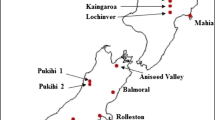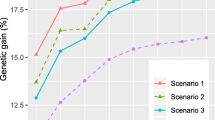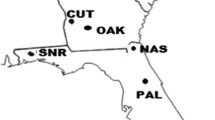Abstract
Different methods for predicting clonal values were explored for diameter growth (diameter at breast height (DBH)) in a radiata pine clonal forestry program: (1) clones were analyzed with a full model in which the total genetic variation was partitioned into additive, dominance, and epistasis (Clone Only—Full Model); (2) clones were analyzed together with seedling base population data (Clone Plus Seedling (CPS)), and (3) clones were analyzed with a reduced model in which the only genetic term was the total genetic variance (Clone Only—Reduced Model). DBH was assessed at age 5 for clones and between ages 4 to 13 at the seedling trials. Significant additive, dominance, and epistatic genetic effects were estimated for DBH using the CPS model. Nonadditive genetic effects for DBH were 87% as large as additive genetic effects. Narrow-sense (\(\hat h^2 \)) and broad-sense (\(\hat H^2 \)) heritability estimates for DBH using the CPS model were 0.14 ± 0.01 and 0.26 ± 0.01, respectively. Accuracy of predicted clonal values increased 4% by combining the clone and seedling data over using clonal data alone, resulting in greater confidence in the predicted genetic performance of clones. Our results indicate that exploiting nonadditive genetic effects in clonal varieties will generate greater gains than that typically obtainable from conventional family-based forestry of radiata pine. The predicted genetic gain for DBH from deployment of the top 5% of clones was 24.0%—an improvement of more than 100% over family forestry at the same selection intensity. We conclude that it is best practice to predict clonal values by incorporating seedling base population data in the clonal analysis.


Similar content being viewed by others
References
Aimers-Halliday J, Menzies MI, Faulds T, Holden DG, Low CB, Dibley MJ (2003) Nursery systems to control maturation in Pinus radiata cuttings, comparing hedging and serial propagation. NZJ For Sci 33:135–155
Araújo JA, Sousa R, Lemos L, Borralho NMG (1996) Estimates of genetic parameters and prediction of breeding values in Eucalyptus globulus combining clonal and full-sib progeny information. Silvae Genet 45(4):223–226
Balocchi CE, Bridgewater FE, Zobel BJ, Jahromi S (1993) Age trends in genetic parameters for tree height in a nonselected population of loblolly pine. For Sci 39(2):231–251
Baltunis BS, Huber DA, White TL, Goldfarb B, Stelzer HE (2007) Genetic gain from selection for rooting ability and early growth in vegetatively propagated clones of loblolly pine. Tree Genet Genomes 3:227–238
Brawner JT (2007) Joint analysis of radiata pine clonal and progeny trials for growth, form and wood quality. In: Australasian Forest Genetics Conference: Breeding for Wood Quality, Program Book, 11–14 April 2007, Hobart, Tasmania. p. 29
Bulmer M (1971) Effect of selection on genetic variability. Am Naturalist 105:201–211
Burdon RD (1971) Clonal repeatabilities and clone–site interactions in Pinus radiata. Silvae Genet 20:33–39
Burdon RD (1989) When is cloning on an operational scale appropriate? In: Gibson GI, Griffin AR, Matheson AC (eds) Proceedings of the breeding tropical trees: population structure and genetic improvement strategies in clonal and seedling forestry. Oxford Forestry Institute, Oxford, pp 9–27
Burdon RD, Shelbourne CJA (1974) The use of vegetative propagules for obtaining genetic information. NZJ For Sci 4:418–425
Burdon RD, Bannister MH, Low CB (1992) Genetic survey of Pinus radiata. 4: variance structures and heritabilities in juvenile clones. NZJ For Sci 22:187–210
Cannell MGR, Sheppard LJ, Cahalan CM (1988) C effects and second generation clone performance in Picea sitchensis and Pinus contorta. Silvae Genet 37(1):15–19
Carson MJ (1986) Control-pollinated seed orchards of best general combiners—a new strategy for radiata pine improvement. In: Proceedings of DSIR Plant Breeding Symposium, pp. 144–149
Carson SD (1991) Genotype × environment interaction and optimal number of progeny test sites for improving Pinus radiata in New Zealand. NZJ For Sci 21:32–49
Cockerham CC (1954) An extension of the concept of partitioning hereditary variance for analysis of covariance among relatives when epistasis is present. Genetics 39:859–882
Comstock RE, Moll RH (1963) Genotype–environment interactions. In: Hanson RE, Robinson HF (eds) Statistical genetics and plant breeding. NAS–NRC Publ. 982. National Academy of Sciences–National Research Council, Washington, pp 53–93
Costa e Silva J, Borralho NMG, Potts BM (2004) Additive and nonadditive genetic parameters from clonally replicated and seedling progenies of Eucalyptus globulus. Theor Appl Genet 108:1113–1119
Dean CA, Cotterill PP, Burdon RD (2006) Early selection of radiata pine I. Trends over time in additive and dominance genetic variances and covariances of growth traits. Silvae Genet 55:182–191
Dungey HS (2006) The genetic value of clones for growth, form and sonic velocity properties in Pinus radiata in the North Island of New Zealand. In: 13th Australasian Plant Breeding Conference, Breeding for success: Diversity in action, 18–21 April 2006, Christchurch, New Zealand. p. 110
Foster GS, Shaw DV (1988) Using clonal replicates to explore genetic variation in a perennial plant species. Theor Appl Genet 76:788–794
Gilmour AR, Gogel BJ, Cullis BR, Thompson R (2005) ASReml user guide release 2.0. VSN International Ltd., Hemel Hempstead, p 267
Hodge GR (1997) Selection procedures with overlapping generations. In: Burdon RD, Moore JM (eds) IUFRO’97 Genetics of Radiata Pine, Proceedings of NZFRI-IUFRO Conference and Workshop, 1–5 December 1997, Rotorua, New Zealand. FRI Bulletin 203, New Zealand Forest Research Institute, Rotorua, New Zealand, pp. 199–206
Isik F, Li B, Frampton J, Goldfarb B (2003) Efficiency of seedlings and rooted cuttings for testing and selection in Pinus taeda. For Sci 50:44–53
Isik F, Goldfarb B, Lebude A, Li B, McKeand S (2005) Predicted genetic gains and testing efficiency from two loblolly pine clonal trials. Can J For Res 35:1754–1766
Jayawickrama KJS (2001a) Estimated among-family and within-family variances and heritabilities from three radiata pine clonal trials. For Genet 8(3):247–257
Jayawickrama KJS (2001b) Genetic parameter estimates for radiata pine in New Zealand and New South Wales: a synthesis of results. Silvae Genet 50(2):45–53
Jayawickrama KJS, Carson MJ (2000) A breeding strategy for the New Zealand radiata pine breeding cooperative. Silvae Genet 49(2):82–90
Jaywickrama KJS, Carson MJ, Jefferson PA, Firth A (1997a) Development of the New Zealand radiata pine breeding population. In: Burdon RD, Moore JM (eds) IUFRO’97 Genetics of Radiata Pine, Proceedings of NZFRI-IUFRO Conference and Workshop, 1–5 December 1997, Rotorua, New Zealand. FRI Bulletin 203, New Zealand Forest Research Institute, Rotorua, New Zealand, pp. 217–225
Jayawickrama KJS, Shelbourne CJA, Carson MJ (1997b) New Zealand’s long-internode breed of radiata pine. NZJ For Sci 27:126–141
Johnson GR, Burdon RD (1990) Family-site interaction in Pinus radiata: implications for progeny testing, strategy and regionalized breeding in New Zealand. Silvae Genet 39:55–62
King JN, Johnson GR (1991) Genetic parameter estimates from a young clonal test. FRI Bulletin 160, NZFRI, Rotorua, New Zealand, pp 98–100
King JN, Carson MJ, Johnson GR (1998) Analysis of disconnected diallel mating designs. II. Results from a third generation progeny test of the New Zealand radiata pine improvement programme. Silvae Genet 47:80–87
Kumar S (2006) Correlation between clonal means and open-pollinated seedling progeny means and its implications for radiata pine breeding strategy. Can J For Res 36:1968–1975
Lerner IM (1958) The genetic basis of selection. Wiley, New York, p 298
Libby WJ, Jund E (1962) Variance associated with cloning. Heredity 17:533–540
Libby WJ, Ahuia MR (1993) Clonal forestry. In: Ahuja MR, Libby WJ (eds) Clonal forestry II: Conservation and application. Springer, New York, pp 1–8
Matheson AC, Lindgren D (1985) Gains from the clonal and the clonal seed-orchard options compared for tree breeding programs. Theor Appl Genet 77:825–831
McKeand SE, Bridgewater FW (1998) A strategy for the third breeding cycle of loblolly pine in the south-eastern U.S. Silvae Genet 47:223–234
Mrode RA (2005) Linear models for the prediction of animal breeding values, 2nd edition. CABI, Wallingford, p 344
Mullin TJ, Park YS (1994) Genetic parameters and age-age correlations in a clonally replicated test of black spruce after 10 years. Can J For Res 24:2330–2341
Mullin TJ, Morgenstern EK, Park YS, Fowler DP (1992) Genetic parameters from a clonally replicated test of black spruce (Picea mariana). Can J For Res 22:24–36
O’Neill GA, Russel JH, Hooge BD, Ott PK, Hawkins CBD (2005) Estimating gains from genetic tests of somatic emblings of interior spruce. For Genet 12(1):57–66
Park YS, Lelu-Walter MA, Harvengt L, Trontin JF, MacEacheron I, Klimaszewska K, Bonga JM (2006) Initiation of somatic embryogenesis in Pinus banksiana, P. strobus, P. pinaster, and P. sylvestris at three laboratories in Canada and France. Plant Cell. Tiss Organ Cult 86:7–101
Powell MB, McRae TA, Wu HX, Dutkowski GW, Pilbeam DJ (2004) Breeding strategy for Pinus radiata in Australia. 2004 IUFRO Joint Conference of Division 2: Forest Genetics and Tree Breeding in the Age of Genomics: Progress and Future. Charleston, South Carolina, USA, 1–5 November, 2004
Russell JH, Libby WJ (1986) Clonal testing efficiency: the trade-offs between clones tested and ramets per clone. Can J For Res 16:925–930
Shelbourne CJA (1992) Genetic gains from different kinds of breeding population and seed or plant production population. South Afr For J 160:49–65
Shelbourne CJA (1997) Genetics of adding value to the end-products of radiata pine. In: Burdon RD, Moore JM (eds) IUFRO’97 Genetics of Radiata Pine, Proceedings of NZFRI-IUFRO Conference and Workshop, 1–5 December 1997, Rotorua, New Zealand. FRI Bulletin 203, New Zealand Forest Research Institute, Rotorua, New Zealand, pp. 129–141
Shelbourne CJA, Thulin IJ (1974) Early results from a clonal selection and testing programme with radiata pine. NZJ For Sci 4:387–398
Shelbourne CJA, Burdon RD, Carson SD, Firth A, Vincent TG (1986) Development plan for radiata pine breeding. New Zealand Forest Research Institute, Rotorua, New Zealand, 142 p
Sorensson C (2006) Varietal pines boom in the US south. NZJ For 51(2):34–40
Sorensson CT, Shelbourne CJA (2005) Clonal forestry. In: Colley M (ed) Forestry handbook. 4th edn. New Zealand Institute of Forestry, Christchurch, pp 92–96
Talbert CB, Ritchie GA, Gupta P (1993) Conifer vegetative propagation: an overview from a commercialization perspective. In: Ahuja MR, Libby WJ (eds) Clonal forestry I: genetics and biotechnology. Springer, New York, pp 145–181
White TL, Huber DA, Powell GL (2003) Third-cycle breeding strategy for slash pine by the cooperative forest genetics research program. In: McKinley CR (eds) Proceedings of 27th Southern Tree Improvement Conference, 25–27 June 2003, Stillwater, OK, pp 17–29
White TL, Adams WT, Neale DB (2007) Forest genetics. CABI, Wallingford, p 682
Wu HX, Matheson AC (2005) Genotype by environment interactions in an Australia-wide radiata pine diallel mating experiment: implications for regionalized breeding. For Sci 51(1):29–40
Ye TZ, Jayawickrama KJS, Johnson GR (2007) Efficiency of including first-generation information in second-generation ranking and selection: results of computer simulation. Tree Genet Genomes 3:319–328
Acknowledgements
The authors are grateful to the Radiata Pine Breeding Company and ArborGen Australasia for access to data used in this research. We also acknowledge reviews by Drs. Charles Sorensson, Washington Gapare, Milos Ivković, Rowland Burdon, and two anonymous referees on earlier versions of this manuscript. Additional support provided by the Juvenile Wood Initiative project is also appreciated.
Author information
Authors and Affiliations
Corresponding author
Additional information
Communicated by R. Burdon
Rights and permissions
About this article
Cite this article
Baltunis, B.S., Wu, H.X., Dungey, H.S. et al. Comparisons of genetic parameters and clonal value predictions from clonal trials and seedling base population trials of radiata pine. Tree Genetics & Genomes 5, 269–278 (2009). https://doi.org/10.1007/s11295-008-0172-y
Received:
Revised:
Accepted:
Published:
Issue Date:
DOI: https://doi.org/10.1007/s11295-008-0172-y




